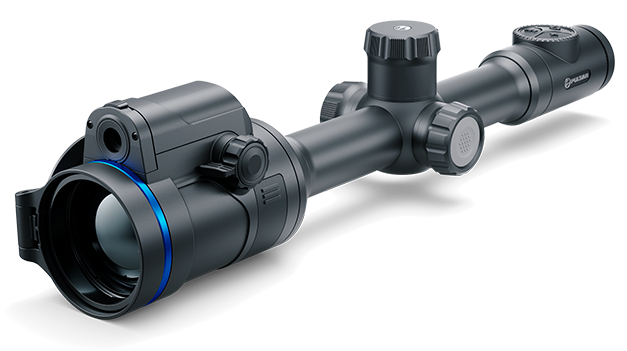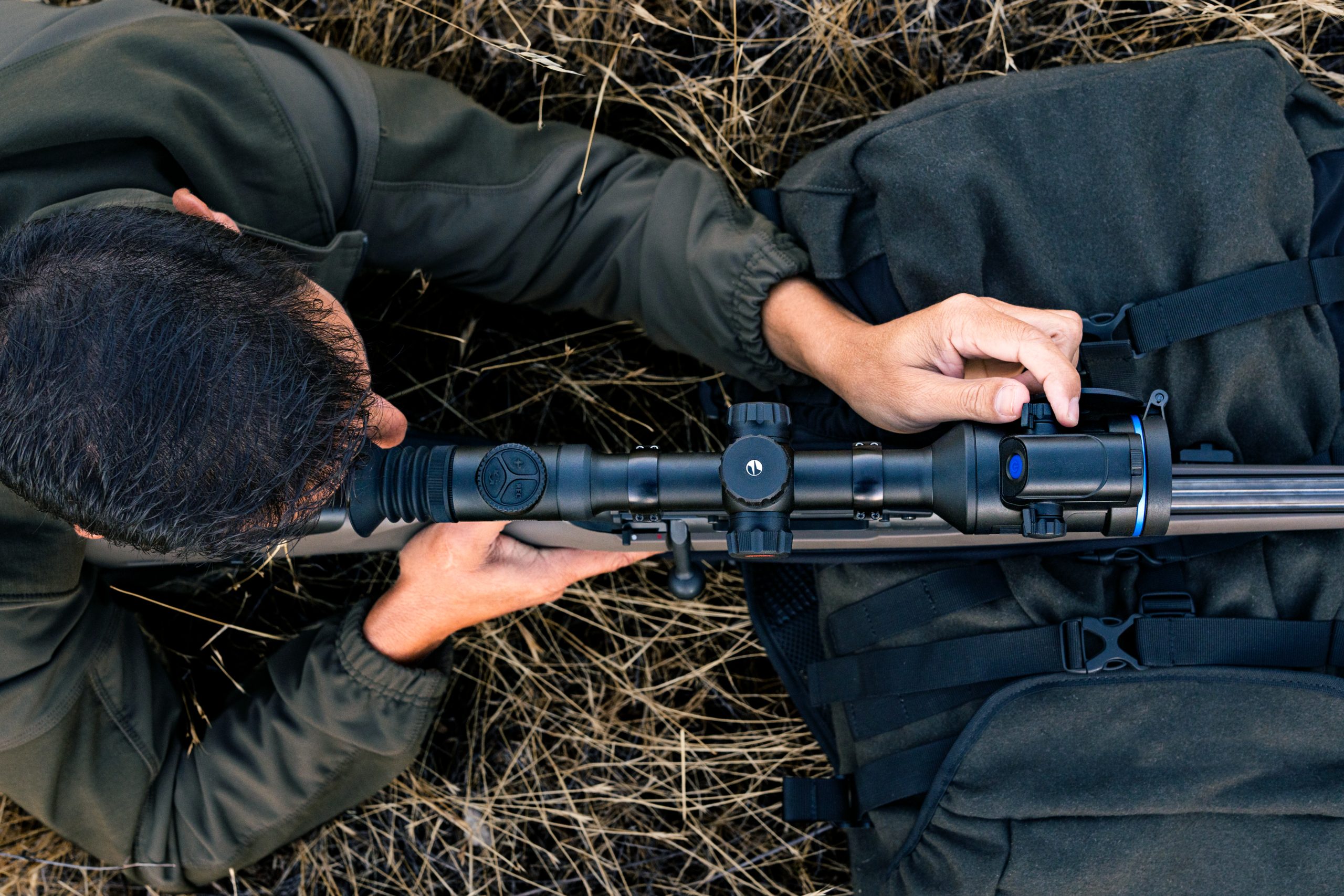The Pulsar Thermion Duo DXP50 certainly raised some waves when we first introduced it. The first hunting riflescope that combines both thermal and digital daytime vision, it’s a step towards the future of hunting. It has been available for some time, and we’re pleased to share what hunters think of it. Have a read!
The magic of multispectral
The Pulsar Thermion Duo DXP50 has its biggest uniqueness encoded in its name – it features two independent channels. One is daytime digital, and the other – a powerful thermal one.
“You would have thought that by adding daytime optics, Pulsar had bargained on the thermal department? Clearly no, as the specifications are the same as for the other high-end thermals in their vast product range,” assures Night Vision Viking, a hunter and equipment tester from Sweden.
His counterpart from Portugal, Jorge Costa – who is also the star of Duo’s launch video, was one of the first to try out the device, and his opinion matches Night Vision Viking’s: “The Thermion Duo DXP50 features amazing quality of both channels, thermal and digital.”
Here is the case, in numbers: Duo features 640×480 pix @ 17 µm thermal imaging sensors – one of the best available in the market. The quality and details it produces together with the F50/1.0 thermal lens are almost legendary by now. Even thick fog and vegetation won’t prevent the riflescope from displaying clear, easily identifiable targets in the thermal mode.
Meanwhile, the 4K CMOS 3840×2160 digital sensor is responsible for displaying an informative image during the day. Many hunters compare its quality to the image you see with your own eyes, and Riccardo Tamburini, a hunter from Italy, notes it “allows the hunter to have great clarity even with maximum magnification.”
And the best part? You can combine the two channels with a Picture-in-Picture mode, prioritizing either thermal or digital image. The function amazes Night Vision Viking “over and over again – to be able to see both images at the same time is fantastic. You will for sure discover things you would not have discovered without this technology. It’s pretty amazing, mind-blowing, and has to be seen with your own eyes to be fully understood and believed.”
Riccardo is, too, a big fan of the feature, naming it as his favorite one: “I love the multitasking feature of PiP windows. The hunter has many options available: from the standard use like the digital or thermal camera to the combination of both; you can decide to have a thermal PiP window on a digital display or vice versa.”
Phil Taylor, representing the hunters of the UK, explains how this can be used in practice: “Having thermal at the touch of a button really helps to spot, say, a muntjac in a scrub as it likes to keep hidden and you sometimes struggle to get onto them with day optics. So, you can get on it with the thermal channel, then switch back to the 4k channel to take the shot.”
And “touch of a button” isn’t a metaphor in this case – all you really need to do to get an either thermal or digital image is press one conveniently placed button, which, in Night Vision Viking’s words, takes “less than a fraction of a second.”
Ready, set, zero
Multispectral vision is still a new technology, so naturally, hunters have various questions. One of the most common Riccardo gets is about zeroing: “Some hunters are scared about the double zeroing which is required because the digital and thermal lenses are in different levels. But I tell them not to worry as it’s very simple. You just need a little more ammo.”
Night Vision Viking sees this as an opportunity: “You can zero the channels independently, which means you can either use the same zero for both channels or choose different ones. For instance, you can zero the thermal channel at 100 meter because you don’t want to take long shots in the dark (European style). For the 4K daytime optic, you can set the zero at 200 meters because you feel more comfortable during that time of the day. Just as long as you remember what you’re doing – always know your zero.
Classic meets ergonomics
“I think the Thermion Duo DXP50 is a fantastic scope, and the idea to have two channels that are very different in the same scope is revolutionary,” Phil says of the device, but we want to delve deeper. Besides the multispectral vision, what other features make it stand out from the crowd?
First, we’d say, is the classic design. Mounting on standard 30 mm rings, it features traditional looks that “blends in on almost any firearm,” says Night Vision Viking, calling it a “good-looking product.”
It also features exemplary ergonomics – all control elements are placed close to the eyepiece, while the focusing wheels are located on each side of the lens, making Thermion Duo DXP50 a truly ambidextrous device. Or, as Jorge has put it: “very user-friendly and simple to operate. It really has it all.”
So, if you like trying new things, being on the edge of technology, and maintaining the classy look, the Pulsar Thermion Duo DXP50 is certainly the way to go. Riccardo also recommends the riflescope for someone who wishes to “avoid mounting different scopes (for example, the standard scope for the day and thermal device for the night), saving a lot of money.”
He also cautions to remember the digital camera is designed for daytime, not twilight and nighttime, like, say, that of Digex C50. That being said, Duo does feature an automatic transition to low-light mode, switching from full-color to black and white image. And leave it to Riccardo to push its limits: “I tried to measure the potential performance of the digital camera during twilight, and, honestly, I was surprised about it because it shows you the animal (B/W image) even in very low light conditions. But it’s not Duo’s job, so don’t expect too much!”
The limitless use
The unique combination of the daytime digital and thermal image makes Thermion Duo DXP50 an extremely versatile device you can use in various situations. As Riccardo puts it, as long as the rules allow, you can use it without any limits: “From the squirrel to the stag, from the rat to the wild boar. Day or night.”
Phil says the scope is ideal for “the recreational stalker who likes to stay out for an hour after dark for a problem fox. I think it would also be great for lads that want to go stalking, then stay out for pest control duties. This way, you have the best of both worlds, with the clarity of a day optics and then thermal for any time.”
We designed the Pulsar Thermion Duo DXP50 for those who love hunting in any conditions but are perhaps put off by the notion of carrying two riflescopes around. As Phil notices, it “will certainly help with the problem of people needing to take two rifles out with them as this is one scope that does it all.”
“I tried to measure the potential performance of the digital camera during twilight, and, honestly, I was surprised about it because it shows you the animal (B/W image) even in very low light conditions.“
Riccardo Tamburini, a hunter from Italy
“Pulsar Thermion Duo DXP50 has an amazing mix of technologies without any apparent flaws. It’s good-looking and ergonomic. It has lots of features, yet it still is easy to use. And while it’s not cheap, you’re worth it!”
Night Vision Viking, a hunter from Sweden

Tapping into the future
It’s perhaps too early to say that Thermion Duo will change the way we hunt, but it is for sure a sight into our future. As Night Vision Viking says, “there’s room for both digital and analog, but considering the possibilities with the high daytime image quality of the Duo in combination with the thermal technology in the same device, this is something everyone should at least take a serious look at.”
So, should you go for one? Of course, we’ll say you should – provided the local authorities allow hunting with digital and thermal where you live. You should, because Thermion Duo DXP50 truly is an outstanding device. As Night Vision Viking summarizes: “It has an amazing mix of technologies without any apparent flaws. It’s good-looking and ergonomic. It has lots of features, yet it still is easy to use. And while it’s not cheap, you’re worth it!”
Before purchasing any night or thermal vision device, please make sure you adhere to the local legislation and only use it when it is allowed. Our ambassadors come from various countries and travel a lot, which allows them to test different devices. We do not encourage or support the illegal use of our devices in any events. If you wish to learn more about export and sales restriction policy, please visit the following link: Export and Sales Restriction Policy.
